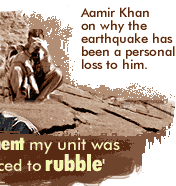|
|
|
|
|
| HOME | MOVIES | BILLBOARD | |||
|
January 31, 2001
5 QUESTIONS
|
 
Komal Nahta Aamir Khan is a man distressed. Having shot the whole of his first home-production, Lagaan, in Bhuj, Gujarat, the actor-turned-charismatic producer has taken the news of the devastation caused by the recent earthquake in Bhuj very personally. The actor had rented a newly-contructed building for the duration of his film. Today, the same building where Aamir, director Ashutosh Gowarikar, art director Nitin Desai and other cast and crew of Lagaan ate, drank and slept, is a mound of debris. "We lived with the locals for six months -- from January 2000 to June 2000," says Aamir, with deep sorrow, adding, "We worked like one big family. Now I have no information about how they are, in what condition they are, what they need... "My staff is just sitting in front of the television, watching the tragedy. We have also been trying constantly to contact our friends in Bhuj over the telephone. Since the lines are down, we are clueless about their well-being." That is why Aamir rushed his production guys to Bhuj on the morning of January 30 to enquire after them. He reveals, "My guys will also contact the local organisation which is engaged in disbursing money, food and clothing to the quake-affected. I could have sent a cheque to the Prime Minister's Relief Fund, but this quake is a personal loss." Meanwhile, the communication lines were restored, and Aamir says, "Our guys who went to Bhuj just called to say that the apartment in which the entire unit was staying had been reduced to rubble." Aamir himself plans to go to Bhuj as soon as he gets word from his production people that the necessary arrangements have been made for the disbursement of goods and cash. He declares, passionately, "I want to personally hand over, with my own hands, whatever my friends and their families there need." What's more, the actor-producer has decided to personally donate Rs 25 lakhs for the cause. "Generous contributions are also coming in from all the unit members," says the affable actor. "Everyone in the unit wants to contribute his bit. Even the spot boys have expressed a keen desire to help with whatever they can afford."
In fact, of the 200 junior artistes in the film, only 50 had been taken to Bhuj from Bombay. "The remaining 150 were from the local theatre groups of Bhuj and the commoners," he discloses. "And the junior artistes are not junior artistes in my film. Each of them is a character. For instance, the role of Raj Zutshi's wife is played by a local girl. She doesn't have a single dialogue in the film, but she is there by Zutshi's side all through the film. "We used to eat and chat with the locals like they were part of our family. I used to often smoke with them. We knew half the people by their first names. It is frightening to think in what state they might be." Aamir then showed me a song from the film to drive home the immense contributions of the people of Bhuj to his film. The Megha song is a joyous number in which the entire parched village (Lagaan has a village backdrop) dances on sighting the first clouds of the season, in the hope that it would rain soon. On his PC, Aamir pauses the pictures at regular intervals and points out to the large number of locals dancing in the song. That the song is an exceptional number composed by A R Rahman is besides the point. In normal circumstances, a producer would be thrilled when told that his song is a hit number. But the pain in Aamir's heart is too palpable for him to accept appreciate for his song. Lagaan also features several British actors. They too have been calling Aamir's office to enquire after the well-being of the Bhuj people. The foreign actors have also very considerately volunteered to help financially. Aamir's cousin, director Mansoor Khan, too is keen to donate his mite for the quake victims, together with the Lagaan team. But Aamir dissuaded him, saying he could use one of the more traditional channels. "I told Mansoor that we will not be able to give him the tax benefits that accrue from donating to charitable organisations. I don't mind paying the tax on my contribution. We aren't going to apply for exemption and all that," he explains.
Lagaan, should, perhaps, be the first commercial Hindi film to have been shot using the sync-dubbing technique which, according to Aamir, "is much more expensive than dubbing the dialogues later." The reason why he went in for sync-dubbing, he explains, is because it "captures the ambience of the scene and also brings in the right emotions. And emotions are a very strong point of Lagaan. "No film can succeed unless there is an underlying emotional point. The seed of Lagaan is very emotional." Little did Aamir imagine that the same emotional tale would test his (and his unit's) emotional strength even before the film was released. Aamir also recounts the deal he had struck with the farmers on whose land he had erected the set of an entire village: "I asked the farmers how much they earned every year from their agricultural produce. I gave them the entire amount before I started the set-construction on their land. I also employed them for the set construction as also as junior artistes in my film -- so they earned more than they would have in one year. Last year, too, was a year of drought, so they had what they earned from us to tide over their bad times." Meanwhile, one wonders how many are alive at all today. The catchline of Aamir Khan's Laagan, set in pre-Independence India, reads: 'Once upon a time in India'. Today, with most of Bhuj buried by the quake, the words that come to mind are 'Once upon a time in Bhuj...'
|
|
Tell us what you think of this report
|
|
|
HOME |
NEWS |
CRICKET |
MONEY |
SPORTS |
MOVIES |
CHAT |
BROADBAND |
TRAVEL ASTROLOGY | NEWSLINKS | BOOK SHOP | MUSIC SHOP | GIFT SHOP | HOTEL BOOKINGS AIR/RAIL | WEDDING | ROMANCE | WEATHER | WOMEN | E-CARDS | HOMEPAGES | FREE MESSENGER | FREE EMAIL | CONTESTS | FEEDBACK |
|